Overview
- A Stanford-led team created an open-source algorithm that designs organ-scale vascular trees in minutes, accelerating previous methods by up to 200-fold.
- SimVascular software converts computational models into 3D-printable instructions and has produced perfusable channels that maintain kidney cell viability in tissue constructs.
- Researchers demonstrated that 3D-printed vessel networks sustain nutrient and oxygen flow, boosting cell survival by over 400-fold compared to nonvascularized controls.
- Boston Children’s Hospital and Harvard Medical School scientists developed a dual transcription factor approach to build vascular organoids from iPSCs in just five days.
- The vascular organoids connect with host blood vessels and support perfusion when transplanted into immunodeficient mice, advancing prospects for transplantable artificial organs.

